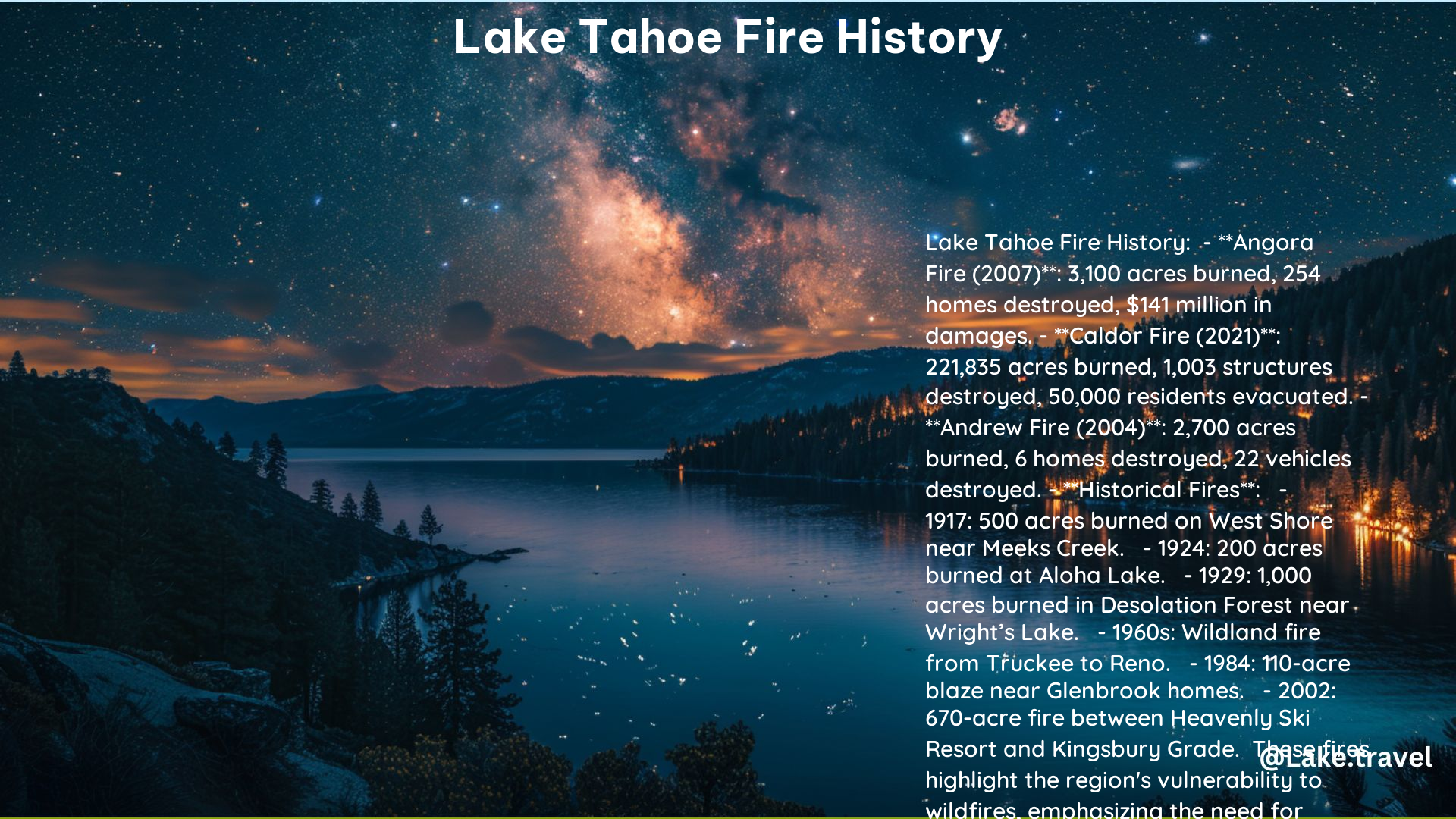Lake Tahoe, situated in the Sierra Nevada mountains, has a rich history of wildfires that have shaped the region’s ecosystem and human settlements. The fire history of Lake Tahoe is a complex interplay of natural and human factors, including the role of the Washoe people, European colonization, logging, and fire suppression.
The Washoe People and Natural Fire Cycle
Before European colonization, the Washoe people inhabited the Lake Tahoe area and played a significant role in shaping the fire history of the region. The Washoe people used fire as a tool for land management, igniting low-intensity fires to maintain open forest canopies and promote forest health. These fires occurred frequently, every 5 to 18 years, and were an integral part of the natural cycle of the ecosystem.
European Colonization and Logging

The arrival of European settlers in the mid-1800s marked a significant shift in the fire history of Lake Tahoe. Intensive logging during the Comstock era in the late 1800s clear-cut the entire Lake Tahoe Basin, leaving the forest decimated. While the forests regrew over the next 100 years, they did so in an unnaturally thick and even-aged state, creating a fire-prone environment.
Fire Suppression and Its Consequences
In the early 20th century, the U.S. federal government adopted vigorous wildfire suppression policies aimed at preserving timber and property. This led to the suppression of natural fires, which in turn allowed fuels to accumulate, making the area vulnerable to high-intensity wildfires. Between 1908 and 2004, no wildfire burned more than 2,000 acres in the Lake Tahoe basin.
Notable Wildfires in Lake Tahoe
- Angora Fire (2007): This wind-driven wildfire destroyed 254 homes and 75 other structures, burning 3,100 acres. It was fueled by strong winds and overgrown forests with hazardous fuels.
- Caldor Fire (2021): This fire burned 221,835 acres, destroyed 1,003 structures, and led to the evacuation of over 50,000 residents. It was exacerbated by drought and climate change, and its spread was slowed by fuel treatments and prescribed fires.
Impact of Colonization, Logging, and Fire Suppression
The history of colonization, logging, and fire suppression has significantly impacted the fire vulnerability in the Lake Tahoe Basin. The suppression of natural fires has allowed fuels to accumulate, making the area prone to catastrophic wildfires. The introduction of non-native species and human activities has disrupted the natural fire cycle, leading to an increased risk of wildfires.
Prescribed Fires and Forest Management
In recent years, there has been a shift towards prescribed fire operations and forest management to reduce the risk of wildfires. The North Lake Tahoe Fire Protection District has been conducting prescribed fire operations since the mid-1990s, focusing on re-entry into treated areas to mimic the natural fire cycle. These efforts aim to reduce the threat of wildfires by creating defensible spaces and promoting forest health.
Conclusion
The fire history of Lake Tahoe is a complex interplay of natural and human factors. Understanding the role of the Washoe people, European colonization, logging, and fire suppression is crucial in managing the region’s fire risk. By adopting prescribed fire operations and forest management strategies, the risk of catastrophic wildfires can be reduced, protecting both the ecosystem and human settlements.
References:
– Reno Gazette-Journal. (2015). A look back: Worst wildfires in Reno-Tahoe. Retrieved from https://www.rgj.com/picture-gallery/news/2015/04/06/a-look-back-worst-wildfires-in-reno-tahoe/70788660/
– North Lake Tahoe Fire Protection District. (2023). THE WHY BEHIND PRESCRIBED FIRE. Retrieved from https://nltfpd.org/news/the-why-behind-prescribed-fire
– Wikipedia. (2023). Angora Fire. Retrieved from https://en.wikipedia.org/wiki/Angora_Fire
– US Forest Service. (2021). Caldor Fire: Defending Lake Tahoe Basin. Retrieved from https://www.fs.usda.gov/about-agency/features/caldor-fire-defending-lake-tahoe-basin
– Tahoe Daily Tribune. (2002). A look at Tahoe’s biggest fires of the century. Retrieved from https://www.tahoedailytribune.com/news/a-look-at-tahoes-biggest-fires-of-the-century/.
